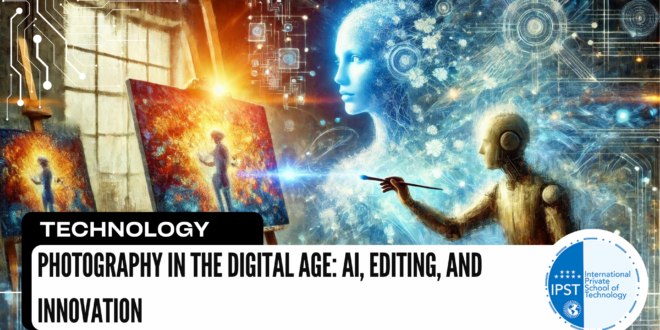Table of Contents
- Introduction to Photography in the Digital Age
- The Rise of Artificial Intelligence in Photography
- The Role of Photo Editing Software
- How Digital Technology Is Changing the Photography Industry
- The Future of Photography: Trends and Innovations
- Conclusion
Photography in the Digital Age
The digital age has brought significant advancements to the world of photography, from the introduction of digital cameras to the integration of artificial intelligence (AI) and advanced editing tools. Photography has become more accessible, versatile, and precise, allowing both amateurs and professionals to capture and enhance images in ways that were once unimaginable. The growth of digital technology has transformed photography into an art form that continuously evolves, pushing the boundaries of creativity.
The Rise of Artificial Intelligence in Photography
Artificial intelligence has revolutionized photography, enabling automatic adjustments, faster editing, and even enhanced creativity. Modern cameras and smartphones are equipped with AI-powered features like auto-focus, scene recognition, and noise reduction, allowing for more precise image capture and improved quality.
AI is also used in photo editing software to streamline the editing process. AI algorithms can recognize elements within a photo, like people, landscapes, and objects, and apply adjustments or enhancements tailored to those elements. For example, programs like Adobe Lightroom and Photoshop utilize AI to automatically enhance the exposure, brightness, and contrast, or even remove unwanted objects from images with minimal effort.
Moreover, AI-powered tools have facilitated the development of “smart” photo editors that can replicate artistic styles, predict aesthetic preferences, and suggest edits based on the context of the photo. This helps photographers and creators save time while ensuring that their images stand out.
The Role of Photo Editing Software
Photo editing software has become a critical component of digital photography, providing photographers with the tools they need to perfect their images. Programs like Adobe Photoshop, Lightroom, and Capture One offer a wide range of features for both beginners and professionals. These software solutions allow photographers to manipulate everything from basic adjustments like exposure and color balance to more complex retouching, compositing, and special effects.
For example, digital retouching has made it easier to alter portraits, correct flaws, or even merge several images into one cohesive composition. Additionally, AI-driven editing tools are making these processes quicker and more accurate, allowing photographers to focus more on their creative vision.
How Digital Technology Is Changing the Photography Industry
Digital technology has significantly altered the business of photography, impacting everything from how photos are taken to how they are shared and sold. In the past, photographers relied heavily on physical film, darkrooms, and manual editing, but digital technology has streamlined and simplified the entire process.
One major change is the rise of online photography platforms. Photographers can now sell their work directly to customers through websites like Shutterstock, Adobe Stock, or personal portfolios. Social media platforms like Instagram and Pinterest have also become powerful marketing tools for photographers, allowing them to showcase their work, build a following, and even collaborate with brands.
Furthermore, the introduction of drone photography, 360-degree cameras, and other innovative devices has opened new frontiers for photography in fields like real estate, tourism, and entertainment. These advancements have enabled photographers to offer unique perspectives and capture images that were once impossible or prohibitively expensive.
The Future of Photography: Trends and Innovations
The future of photography is undoubtedly intertwined with advancements in AI, augmented reality (AR), and virtual reality (VR). AI is likely to continue playing a key role in improving automation, image recognition, and editing. Additionally, AR and VR are expected to provide immersive photography experiences, such as virtual photo galleries or interactive image editing tools.
The development of computational photography, which combines multiple images to create a single, enhanced photo, will likely drive innovation in camera technology. With advances in smartphone cameras, the distinction between professional and consumer-grade photography equipment will continue to blur, allowing more people to create stunning images with ease.
Moreover, the use of blockchain technology for digital rights management and ownership could revolutionize the way photographers protect and monetize their work. Blockchain could help ensure that photographers are fairly compensated for their digital assets and that their rights are clearly established in the digital marketplace.
Photography in the digital age has evolved tremendously, thanks to innovations in AI, photo editing software, and digital imaging technology. These advancements have not only made photography more accessible but have also opened up new creative possibilities for photographers of all skill levels. As technology continues to advance, the future of photography promises even more exciting opportunities for artists and creators to push the boundaries of visual storytelling.
 International Private School of Technology المدرسة الدولية الخاصة للتكنولوجيا Private School مدرسة خاصة للتكوين المهني
International Private School of Technology المدرسة الدولية الخاصة للتكنولوجيا Private School مدرسة خاصة للتكوين المهني


